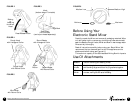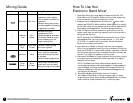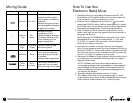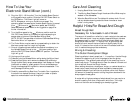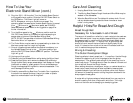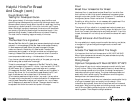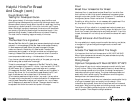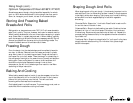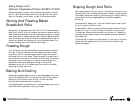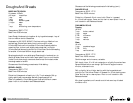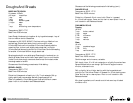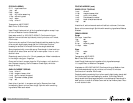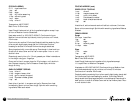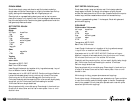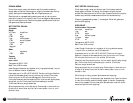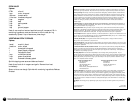
13.12.
Electric Stand Mixer Use and Care Guide
Shaping Dough And Rolls
When shaping and rolling out dough, it is extremely important not to
add additional flour to the working surface. Instead, if dough appears
to be slightly sticky when shaping, lightly spray your hands or working
surface with a non-stick vegetable spray or coat with vegetable
shortening.
Cloverleaf Rolls - Shape into
1
⁄
2
inch balls. Place 3 balls in each muffin
tin and let rise until double in size.
Crisscross Rolls - Shape into balls, setting two aside. Combine the two
balls and roll into a
1
⁄
8
inch thick square. Cut strips
1
⁄
8
-inch wide and
2-inches long. Place one strip across the top of each roll. Repeat this
process, placing the second strip in the opposite direction across the
top of each roll.
Traditional Rolls - Shape into dough balls. For "pull apart" rolls, place
dough balls with sides touching. For individual rolls, place dough
balls 2 inches apart.
Rising Dough (cont.):
Optimum Temperature Of Room 80°-85°F/27°-29°C
Sometimes a second dough rising is beneficial especially for whole
grain or 100% whole wheat bread. Let the dough rise once, punch
down, let rise again, punch down, let rest 10 minutes and shape.
Storing And Freezing Baked
Breads And Rolls
Refrigeration or temperatures under 70°F/21°C will cause breads to
stale (firm) quickly. They can, however, be frozen for several months.
When freezing breads and rolls, cool them before wrapping in plastic
wrap. Place them in a plastic bag and seal it. When thawing, partially
open the wrapping to allow the moisture to escape gradually. Do not
remove ice crystals from the wrap during the thawing process. The
bread will absorb some of this moisture as it thaws.
Freezing Dough
Form the dough into the desired shape and immediately freeze for
one hour to harden. Remove from the freezer and wrap in plastic
wrap. Next, place it in a plastic bag and seal. Dough can be kept in
the freezer for up to four weeks. Thaw the dough in a plastic bag in
the refrigerator overnight or for several hours. Unwrap and place on
baking pan. Cover and let stand in a warm, draft-free place until
double the original size. Because the dough is not at room
temperature, you will find it takes longer than usual to rise. Bake
according to recipe instruction.
Baking And Cooling
When baking sweet breads or braids, it may be necessary to tent the
top of the bread with foil for the last 5-10 minutes. To tent, place a
piece of foil, shiny side up, over the loaf. This will avoid over
browning while the bread continues baking.
Cool baked bread in a draft-free area. To prevent soggy crust, cool on
racks. Wait 20 minutes before cutting hot bread.



